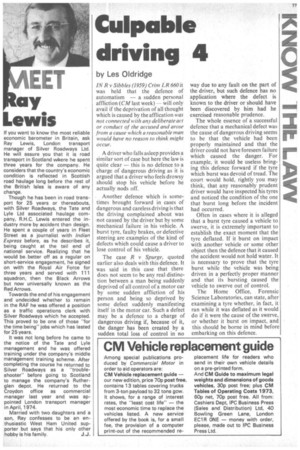Culpable driving 4
Page 75

If you've noticed an error in this article please click here to report it so we can fix it.
by Les Oldridge
IN R v Sibbles (1.959) Crim LR 660 it was held that the defence of automatism — a sudden personal affliction (CM last week) will only avail if the deprivation of all thought which is caused by the afflication was not connected with any deliberate act or conduct of the accused and arose from a cause which a reasonable man would have no reason to think might oCCUP.
A driver who falls asleep provides a similar sort of case but here the law is quite clear — this is no defence to a charge of dangerous driving as it is argued that a driver who feels drowsy should stop his vehicle before he actually nods off.
. Another defence which is sometimes brought forward in cases of dangerous and careless driving is that the driving complained about was not caused by the driver but by some mechanical failure in his vehicle. A burst tyre, faulty brakes, or defective steering are examples of the kind of defects which could cause a driver to lose control of his vehicle.
The case R v Spurge, quoted earlier also deals with this defence. It was said in this case that there does not seem to be any real distinction between a man being suddenly deprived of all control of a motor car by some sudden affliction of his person and being so deprived by some defect suddenly manifesting itself in the motor car. Such a defect may be a defence to a charge of dangerous driving if, because of it, the danger has been created by a sudden total loss of control in no way due to any fault on the part of the driver, but such defence has no application where the defect is known to the driver or should have been discovered by him had he exercised reasonable prudence.
The whole essence of a successful defence that a mechanical defect was the cause of dangerous driving seems to be that the vehicle had been properly maintained and that the driver could not have foreseen failure which caused the danger. For example, it would be useless bringing this defence forward if the tyre which burst was devoid of tread. The court would hold, rightly you may think, that any reasonably prudent driver would have inspected his tyres and noticed the condition of the one that burst long before the incident had occurred.
Often in cases where it is alleged that a burst tyre caused a vehicle to swerve, it is extremely important to establish the exact moment that the tyre deflated. If it burst on impact with another vehicle or some other object then the defence that it caused the accident would not hold water. It is necessary to prove that the tyre burst while the vehicle was being driven in a perfectly proper manner and that its bursting caused the vehicle to swerve out of control.
The Home Office, Forensic Science Laboratories, can state, after examining a tyre whether, in fact, it ran while it was deflated as it would do if it were the cause of the swerve, or whether it burst on impact, and this should be borne in mind before embarking on this defence.




































































































































